Short Version of Providence: Bought this scope at the Grand Rapids Community College Physics Department Garage Sale in 1993ish for 15 bucks. I am sure they bought it new, and at the time we had much newer scopes than this, so it probably hadn't been used in twenty years. From there I used it exactly twice, then it sat under the basement stairs at my moms house until 2017, at which point I moved it to my basement. It worked fine the last time I turned it on in 1994. I have not tried recently.
I had always thought I would use this someday, especially now that I have picked up this electronics habit, oops, I mean hobby. Knowing what I know now, it seems like a mountainous project. I have been restoring an old McIntosh tube amp recently and I see a bunch of the same issues here. There are about a half dozen tall can capacitors in the power supply that I am sure are all dried up. I am not sure how I would even go about replacing them since I haven't had any luck on a service manual to tell me the values (Radio museum has five pages but not even close to the whole thing). It has a half dozen bumble bee caps in it, and half of them are cracked. I spotted what look to be multiple selenium rectifiers all over it. And the tubes - There are like 30 of them in here. Only one was cracked, but replacement tubes for this monster would cost more than a decent used modern-ish scope.
I guess I am wondering - is restoring stuff like this even a thing? I am thinking about just grabbing all the great vintage tubes out of it and calling it a day. I was shocked to see a half dozen Telefunken 12AU7s in at as well as a few 12AT7s too (labeled HP but probably made by someone else).
Thank you.
-Geoff
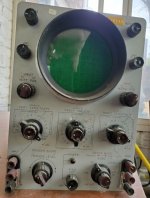
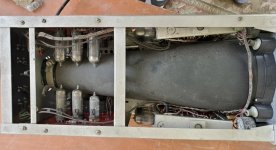
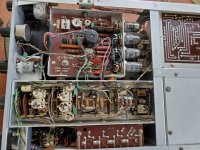
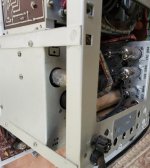
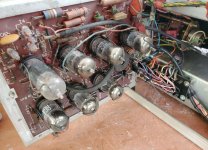
I had always thought I would use this someday, especially now that I have picked up this electronics habit, oops, I mean hobby. Knowing what I know now, it seems like a mountainous project. I have been restoring an old McIntosh tube amp recently and I see a bunch of the same issues here. There are about a half dozen tall can capacitors in the power supply that I am sure are all dried up. I am not sure how I would even go about replacing them since I haven't had any luck on a service manual to tell me the values (Radio museum has five pages but not even close to the whole thing). It has a half dozen bumble bee caps in it, and half of them are cracked. I spotted what look to be multiple selenium rectifiers all over it. And the tubes - There are like 30 of them in here. Only one was cracked, but replacement tubes for this monster would cost more than a decent used modern-ish scope.
I guess I am wondering - is restoring stuff like this even a thing? I am thinking about just grabbing all the great vintage tubes out of it and calling it a day. I was shocked to see a half dozen Telefunken 12AU7s in at as well as a few 12AT7s too (labeled HP but probably made by someone else).
Thank you.
-Geoff





I had wanted a scope forever for hobby purposes and got a Rigol. I use the thing more than I thought I would. Just used it yesterday to make sure the SPI interface signals from an ADC were clean after being level shifted. You pretty much have to have a sampler to do that kind of stuff, so I think an old style scope is going to be wanting if you do any digital hobby stuff. My vote is to spend the money on a sampler. My 2c.
Worth restoring?
I'm going to say that if you would be restoring it to use yourself then no, it is hopelessly low spec by any standards. 300kHz bandwidth for example. Its heavy, it will run hot hot hot...
As to new digital vs older analogue I'll say that a good analogue scope (a bit more modern that this one 😉) with something like a modest 30Mhz (so 100 times more than this one) will resolve and winkle out detail that 8 bit digital scopes can only dream of. In fairness both have their pros and cons of course and analogue scopes are fading into history. If you want one and can get a good one at a reasonable price then go for it would be my advice.
Back to this one, it would be like restoring a vintage TV from the early days of broadcasting. Fine as an interest and hobby but pretty limited if you want to actually use it for real in the modern world.
I'm going to say that if you would be restoring it to use yourself then no, it is hopelessly low spec by any standards. 300kHz bandwidth for example. Its heavy, it will run hot hot hot...
As to new digital vs older analogue I'll say that a good analogue scope (a bit more modern that this one 😉) with something like a modest 30Mhz (so 100 times more than this one) will resolve and winkle out detail that 8 bit digital scopes can only dream of. In fairness both have their pros and cons of course and analogue scopes are fading into history. If you want one and can get a good one at a reasonable price then go for it would be my advice.
Back to this one, it would be like restoring a vintage TV from the early days of broadcasting. Fine as an interest and hobby but pretty limited if you want to actually use it for real in the modern world.
I still have a 130B, the "updated" and rackmount version with 500kHz bandwidth. It was my first scope, I paid $300 for it in the early 80's from a reputable refurbisher in CA. I liked that it had diff inputs. But within a couple weeks the need for more bandwidth for most troubleshooting work became obvious.
I have kept it mostly for sentimental reasons. And, it has little if any market value. I think Mooly summed it up pretty well. Is it cool? Sure. Is it useful? Not very. Is it worth restoring? That's your call.
I have kept it mostly for sentimental reasons. And, it has little if any market value. I think Mooly summed it up pretty well. Is it cool? Sure. Is it useful? Not very. Is it worth restoring? That's your call.
IF it works as is, just use it, it´s good enough for everyday analog amp work. preamps, chipamps, etc.
If you need any restoring at all besides replacing a cracked knob or mains plug, just junk it.
Sorry.
If you need any restoring at all besides replacing a cracked knob or mains plug, just junk it.
Sorry.
If you pull those tubes and sell them on ebay, you can probably pay for a new,
quality scope costing around $300-$400. There's a list of the tubes in the manual.
http://hparchive.com/Manuals/HP-130A-Manual.pdf
quality scope costing around $300-$400. There's a list of the tubes in the manual.
http://hparchive.com/Manuals/HP-130A-Manual.pdf
Looks like a source for some good parts. The tek tube occiloscope is dissasembled had tones of great stuff. And many valuable tubes.
dave
dave
Wow - thank you for the manual link! Looks like there is an 12AX7 hiding in there, and I need one for my MC240 project!
And I agree, it is nice, but not nice enough to restore. I had been thinking that, I was just looking for some confirmation. I have way too many projects to put time into this right now. Will definitely pull these tubes though, and sell some to at least partially offset the newer scope that I need.
Thank you!
-Geoff
And I agree, it is nice, but not nice enough to restore. I had been thinking that, I was just looking for some confirmation. I have way too many projects to put time into this right now. Will definitely pull these tubes though, and sell some to at least partially offset the newer scope that I need.
Thank you!
-Geoff
You don't wanna try to restore an old scope like that, the technology is obsolete, and of academic interest only.Wow - thank you for the manual link! Looks like there is an 12AX7 hiding in there, and I need one for my MC240 project!
And I agree, it is nice, but not nice enough to restore. I had been thinking that, I was just looking for some confirmation. I have way too many projects to put time into this right now. Will definitely pull these tubes though, and sell some to at least partially offset the newer scope that I need.
When you pull the tubes and clean off the dust, be careful not to wipe off the silk screen lettering, which is easy to do.
That makes them more valuable for resale. Don't underestimate how much slightly used Telefunkens are worth now.
I don't agree. If you feel happy with your vintage scope and has the hability for restoring it, do it and enjoy.
I had a Paco 5.5MHz https://www.ricomputermuseum.org/collections-gallery/test-equipment/paco-s-55-oscilloscope from the tube TV era and was of full interest in my firsts projects.
Respect to run hot, it is not true. It hasn't fans like new digital fool.
Start replacing electrolytics and paper capacitor (wax covered units) and checking resistors (mainly high valued ones).
Keep attention to voltages an the CRT socket. Some 2KV may be at the cathode if it is DC coupled to vertical amp. Also, high capacitance valued caps may retain such voltages several minutes post switching it off.
I had a Paco 5.5MHz https://www.ricomputermuseum.org/collections-gallery/test-equipment/paco-s-55-oscilloscope from the tube TV era and was of full interest in my firsts projects.
Respect to run hot, it is not true. It hasn't fans like new digital fool.
Start replacing electrolytics and paper capacitor (wax covered units) and checking resistors (mainly high valued ones).
Keep attention to voltages an the CRT socket. Some 2KV may be at the cathode if it is DC coupled to vertical amp. Also, high capacitance valued caps may retain such voltages several minutes post switching it off.
Last edited:
That is where I am stuck. I am in the middle of restoring an MC240 which is very similar - similar power supply, rectifiers, and old caps. not to mention tubes. Not sure what doing another one would be worth from a learning standpoint. I need equipment that works, not that needs work.If you restored it, or at least overhauled it, would you learn something?
There are definitely more Telefunken 12AU7 tubes than I need. Selling those should go a ways towards buying a modern scope.
Thank you.
-Geoff
I got a HP 120. With a hole punched in it. It actually worked (see trace in image), but with issues. It probably was stored in a damp barn for many years and was tarnished in sockets and switches. I could make it work with much jiggling. I did not complain about the "low bandwidth" because it was faster and far better balanced than two of my prior 'scopes (an Eico 427 and a rebuilt pre-war Allen B DuMont).
However most of today's pocket-scopes are more practical, even if jaggy and susceptible to hi-voltage.

However most of today's pocket-scopes are more practical, even if jaggy and susceptible to hi-voltage.
Not in the case of those CRT's. They don't have aquadag outside the glass bulb and low capaciance between anode and ground. In any instances, in the PSU may be a 1uF or so as 50/60 hz filter for cathode voltage. Generally, the voltage dividing network to bias the electrodes of the CRT (focus, grid, etc) form a natural discharge path, but be careful anyway.CRTs are themselves capacitors, and they can store a high voltage for a long time.
Several models use large negative bias at cathode and heater in order to have deviation plates and focus anode close to the final stage vertical deflection voltage to provide DC coupling or low potential diference in the coupling cap if any. So, the deflection plates may be at +250DCV as opposite to -2000DCV for example. Note that CRT heater is NOT earted and is very close to cathode voltage.
My suggestion at start is to locate and remove temporarily both rectifiers, low and high voltage, for example, a 2X2 and a EY81 or the like. Then, run the dut in series with a 200W filament lamp (no LED nor fluorescent) and let the main transformer to heat and evacuate humidity from it. Light bulb must run dark. If it runs very very brighty, may be a shorted HV winding in the transformer. If you don't have a bulb at hand, use a similar power solder iron or heater in place of it. The idea is to make a current limited voltage source whilst few firsts hours of powering the stuff.
If anyone wants the tubeless carcass let me know. I am in metro Detroit and would drive in the area for a meet-up if you are not in a hurry.
-Geoff
-Geoff
If you can imagine having a longer term interest in building your own tube amps, then the power transformer with its range of supply options could be useful.If anyone wants the tubeless carcass let me know. I am in metro Detroit and would drive in the area for a meet-up if you are not in a hurry.
-Geoff
I had an old Tektronix which I dismantled, and have managed to repurpose a lot of the hardware (after I found a source for a 1/32" Allen key!). The aluminium from the case ended up as baseplates, and the screw/banana plug sockets are useful for speaker posts. The tag boards can be reused, and the tube sockets would have been excelllent quality.
Another side effect of dismantling it was to gain some knowledge about how it was put together in the first place, and appreciate that art. I learnt a lot about the thought that needs to go into wiring point-to-point.
I would go for a 100MHz analogue scope.
The digital stuff is OK but the sampling rates usually need dividing by about 50 to get a realistic bandwidth.
I do have a 20 meg/samples USB scope but its only good for 1MHz signals at best.
The digital stuff is OK but the sampling rates usually need dividing by about 50 to get a realistic bandwidth.
I do have a 20 meg/samples USB scope but its only good for 1MHz signals at best.
- Home
- Design & Build
- Equipment & Tools
- Old Scope - Worth Restoring? HP130a circa 1955